Vishvesh Shah
Director of Product Management
Litmus Edge's commitment to incorporating TPM into its platform demonstrates its dedication to providing customers with the highest level of security for their industrial operations.
In this blog, we delve into the Unified Namespace (UNS) through the lens of industrial data journey.
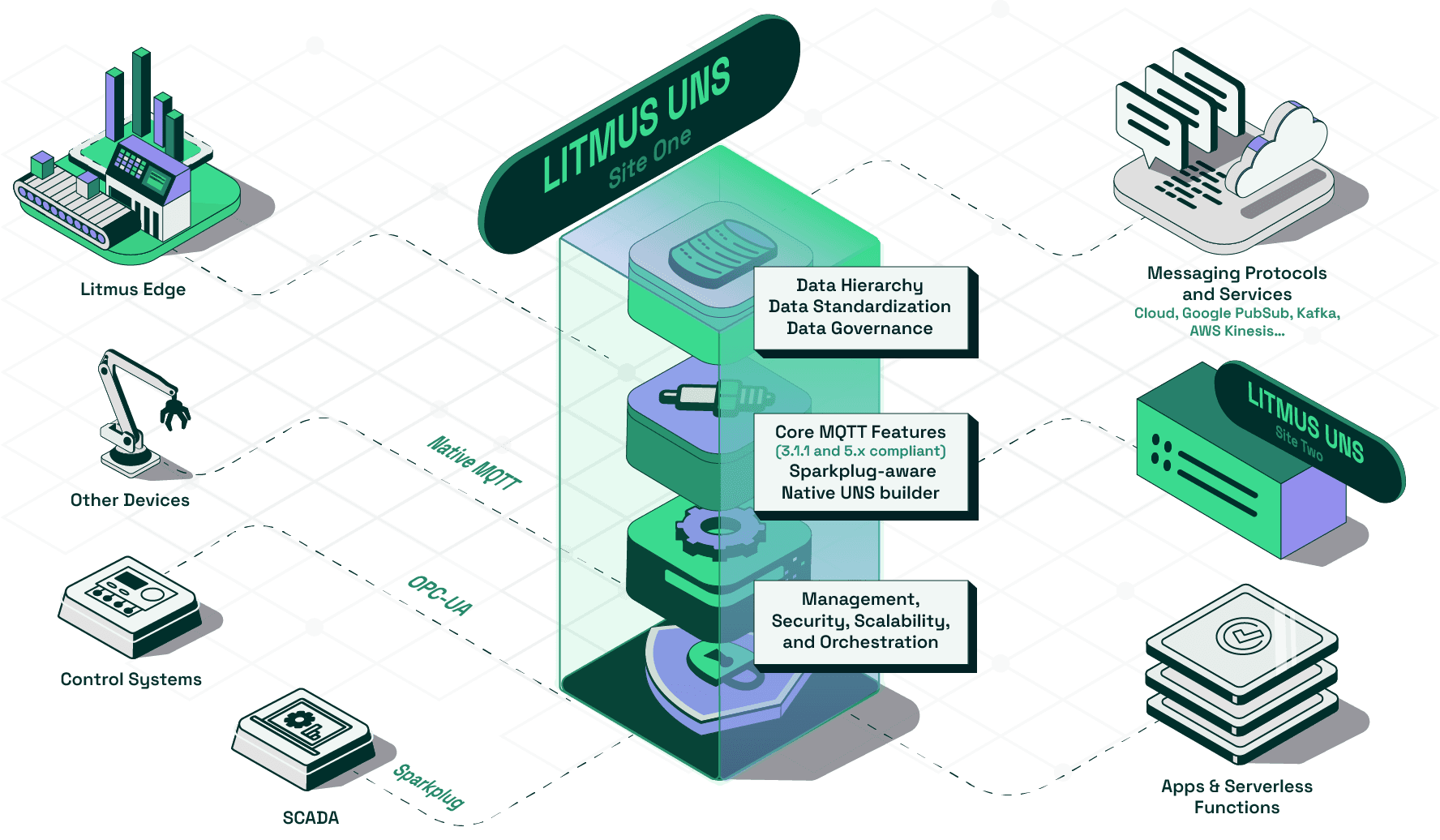
More specifically, we will take a closer look at Litmus UNS, a fully packed ready-to-use UNS product designed with a revolutionary data broker at its core to streamline industrial data management. By leveraging MQTT and the foundational strengths of Litmus Edge, Litmus UNS creates a cohesive environment for data sharing, accessibility, and governance - ultimately enhancing operational efficiency and decision-making.
Get Started With Litmus UNS, Today.
Litmus UNS is designed to simplify the complexities of data infrastructure found in industrial settings. By providing a standardized approach to data management, it bridges the gap between different systems, enabling seamless communication and data flow. This holistic solution empowers organizations to harness their data effectively, driving innovation and operational efficiency.
Since its inception, Litmus has launched multiple products aimed at enhanced data collection and integration. The first product, Litmus Edge, was followed by Litmus Edge Manager, and then the Litmus Unified Namespace. Each product was developed based on rigorous customer feedback to ensure it meets the needs of the users and addresses the challenges faced in the industrial sector.
The journey of Litmus has been marked by a commitment to understanding the data landscape and providing solutions that facilitate a complete data journey. This journey encompasses everything from data sourcing—from control systems and sensors—to deriving actionable insights that drive strategic decisions.
The industrial data infrastructure is notoriously complex, often composed of various legacy systems and purpose-built applications. Each system tends to have its own data structure and management processes, leading to significant data silos. These silos complicate efforts to create meaningful data-driven innovations, making the process time-consuming and expensive.
For instance, organizations often find themselves struggling to extract and integrate data from disparate sources, such as SQL databases, historian systems, and specialized applications. This fragmentation not only hinders innovation but also creates inefficiencies that can slow down operations.
Check out our extensive list of Litmus Edge connectors that enable seamless data collection.
One of the major challenges faced by organizations in the industrial sector is the lack of repeatability in data-driven projects. Many companies report spending excessive time and resources collecting data, with some taking nearly a year to consolidate information from various systems.
Furthermore, the process of creating actionable key performance indicators (KPIs) can be lengthy, often taking months. Applications designed to drive ROI, such as predictive maintenance and advanced manufacturing analytics, typically require extensive data preparation and integration efforts.
This complexity is exacerbated when attempting to scale successful innovations across multiple sites or assets. As organizations strive to replicate success, they often encounter obstacles due to the fragmented nature of their data systems, leading to frustration among innovators.
To address the myriad challenges posed by fragmented data systems (aka data from multiple sources), there is a pressing need for a Unified Namespace. This concept provides a centralized framework for managing data across diverse sources, allowing organizations to streamline their data integration processes.
The Unified Namespace acts as a data broker, facilitating communication between operational technology (OT) and information technology (IT) systems. By leveraging a standardized approach, it enables consistent data governance and management, which is crucial for achieving reliable insights and analytics.
With the Unified Namespace, organizations can overcome the limitations of traditional data architectures, ensuring that data flows seamlessly from edge devices to cloud systems. This capability is vital for enabling real-time decision-making and driving efficiency in industrial operations.
The Unified Namespace boasts several key features that set it apart from traditional data management solutions. First, it provides a structured hierarchy for data, allowing for easy navigation and access to information across various systems.
Standardization
The Unified Namespace normalizes data formats, ensuring consistency regardless of the source. This is particularly beneficial when integrating data from legacy systems.
Data Governance
It establishes clear governance protocols, enhancing data quality and compliance across the organization.
Interoperability and Data Accessibility
The Unified Namespace can integrate with various systems, including SCADA and MES, allowing for comprehensive visibility into operations.
Scalability
As organizations grow, the Unified Namespace can easily scale to accommodate additional data sources and increased data volume.
These features collectively empower organizations to unlock the full potential of their industrial data, driving innovation and improving operational efficiency.
Learn more about the features in Litmus UNS.
To illustrate the practical application of the Litmus UNS, let's examine a real-world scenario involving a customer in the beverage industry. This customer operates twenty sites, with a mix of greenfield and brownfield facilities.
They have been leveraging Litmus technology since the private beta launch of the UNS, which occurred in late 2022. Their existing data infrastructure was already extensive, making the integration into the UNS smoother. With approximately ninety percent of their plant data collected through Litmus Edge, the groundwork was well established.
However, the customer faced significant challenges. They needed a unified data structure across their diverse plants, which included both legacy systems and newly acquired operations. This consistency was crucial for effective data consumption by their analytics tools, such as Databricks.
Read this insightful blog on the 3-way tug of way between IT, OT, and Business teams.
Connecting devices to the Litmus UNS is a streamlined process. The integration allows for the seamless flow of data from various sources, including sensors, machines, and existing data systems. The aim is to establish a cohesive data environment that supports real-time analytics and decision-making.
In this scenario, the customer utilized Litmus Edge to connect their Siemens and Allen Bradley devices. By using prebuilt connectors, they easily integrated these devices into the UNS. This capability ensures that data from diverse sources can be standardized and made accessible within the unified structure.
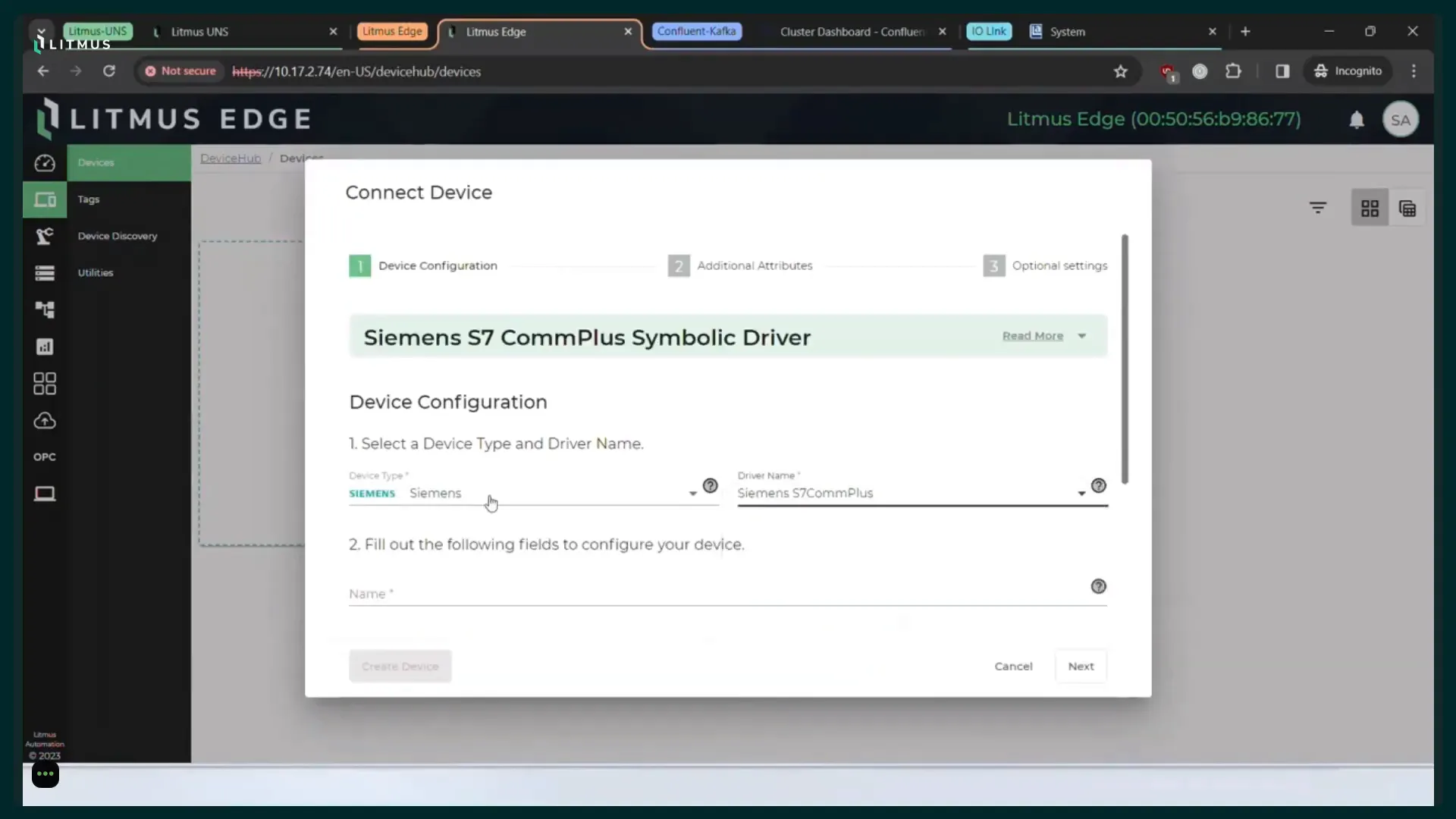
The demonstration of the Litmus UNS showcases its core functionalities. At the heart of the UNS is an enterprise-grade MQTT broker capable of handling over a million messages per second. This robust architecture supports seamless data integration and ensures high availability.
Users can define their data hierarchy within the UNS, allowing for organized access to information across various levels—from enterprise to sensor. This structured approach is pivotal for managing the complexities of industrial data.
Watch the YouTube video on how Litmus UNS works.
Defining a data hierarchy is a critical step in utilizing the Litmus UNS effectively. Users can create a structured rule set that organizes data from enterprise level down to individual sensors. For instance, a company could define its structure as follows: ABC Corp, with sites in Houston and Dallas, each having specific production lines.
Once the hierarchy is established, users can save these configurations and set up access control lists to manage permissions. This ensures that only authorized personnel can access or modify certain data within the UNS.
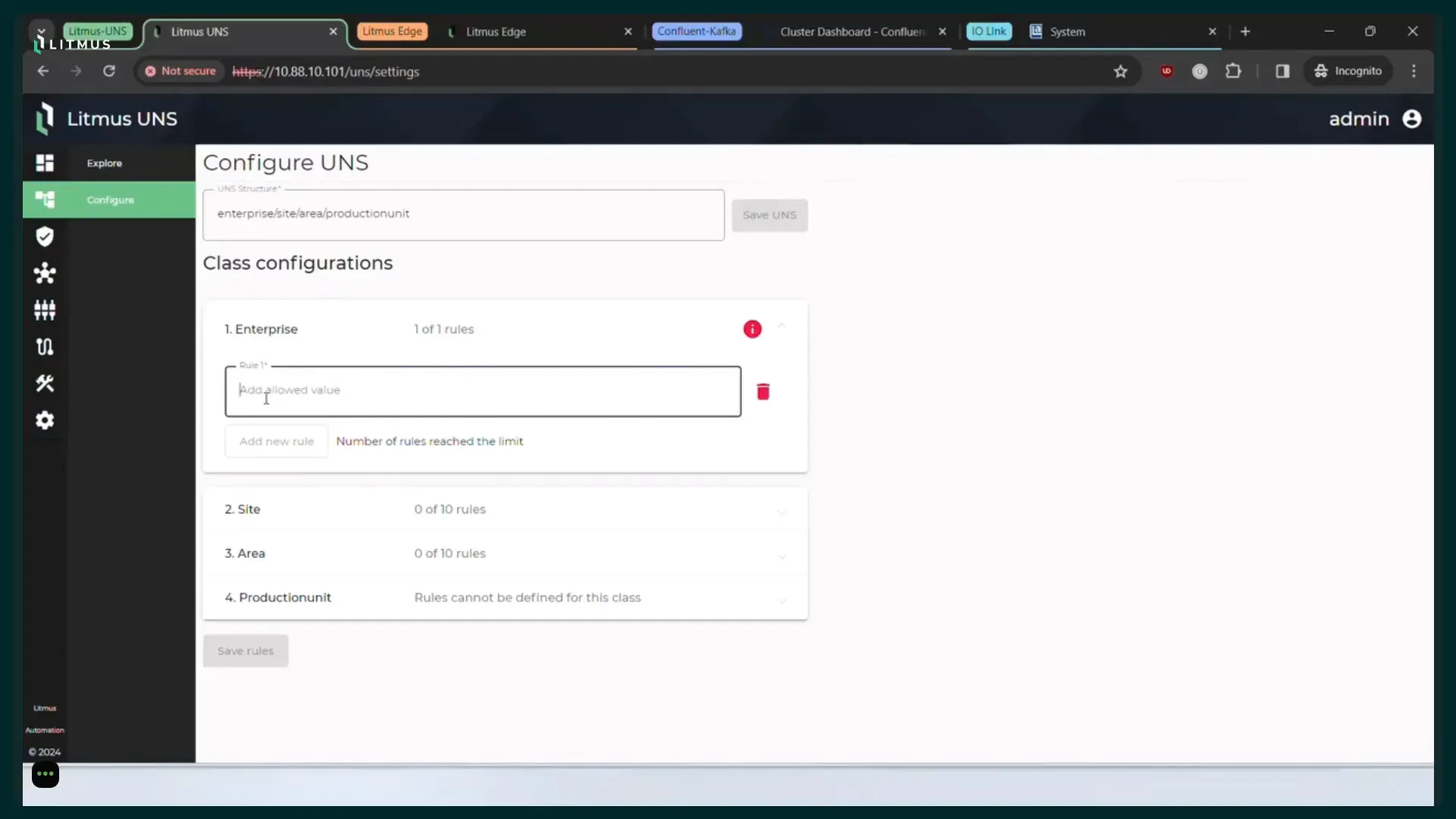
Data governance is essential for maintaining the integrity and quality of data within the UNS. By enforcing consistent naming conventions, formats, and structures, organizations can ensure that their data remains reliable and interoperable.
In the case of our beverage industry customer, they needed to implement governance policies that dictated how data was published and accessed. This includes determining who can modify data and how it is stored and archived. Effective governance not only protects data but also enhances its usability across the organization.
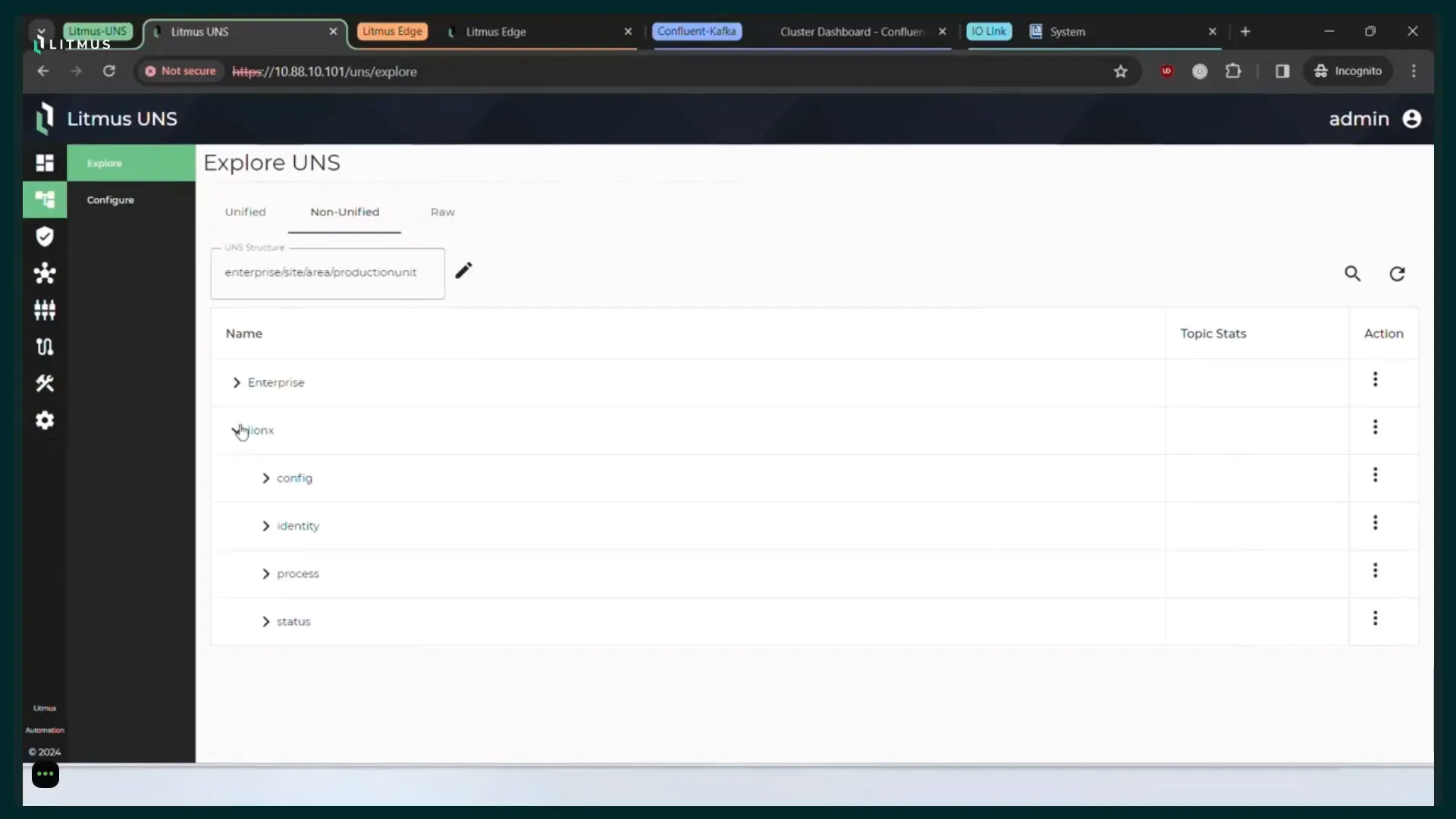
Integrating Kafka with the Litmus UNS allows for efficient data streaming and exchange between different UNS instances. This capability is vital for organizations that require real-time data analysis and data processing across multiple locations.
For the beverage industry customer, the Litmus UNS was preconfigured to stream Kafka data to a Confluent topic called 'Litmus UNS.' By defining wildcards at the UNS level, they could ensure that relevant data was captured and utilized effectively.
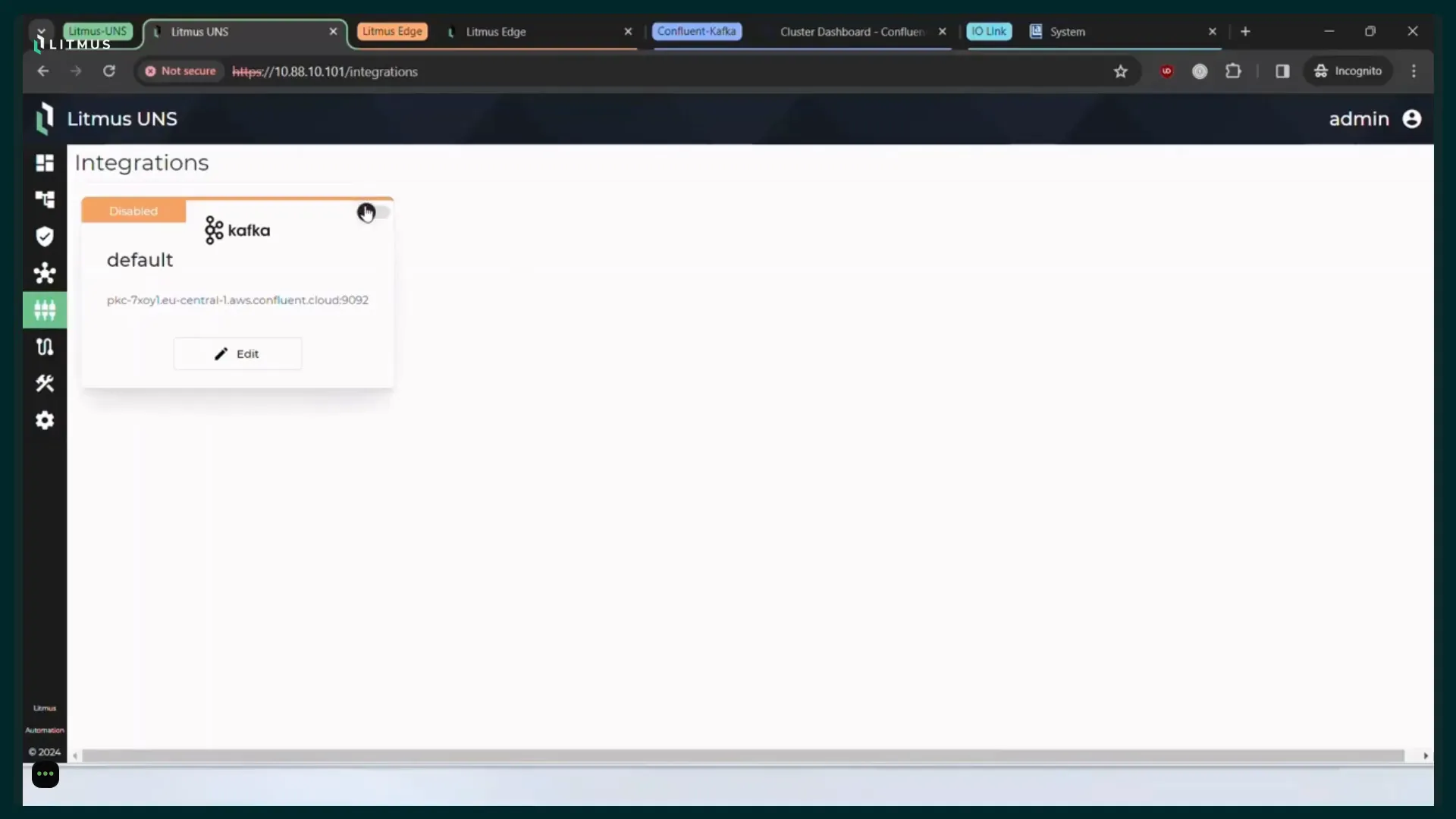
As with any innovative technology, the development of the Litmus Unified Namespace (UNS) faced its share of challenges. A key hurdle was managing metadata effectively. The existing topic structures in MQTT lacked the capacity to carry adequate metadata, making it difficult to define connected systems properly.
For instance, when customers requested specific data from devices, such as blow molders, they often found it challenging to query and discover the relevant information. This limitation highlighted the need for an enhanced query interface to facilitate easier data retrieval without relying solely on hierarchical structures.
Another significant challenge involved ensuring compliance with various data standards, such as Sparkplug B and OPC UA. While the UNS is designed to accommodate these standards, the integration often required additional effort. For example, data that did not conform to the established structure had to be managed separately, complicating governance.
Moreover, the integration of non-standard data formats required the development of a schema registry. This was crucial for ensuring consistent data flow and usability across different platforms. The team is actively working on this registry to streamline future integrations.
The recent AMA session highlighted several questions from users, reflecting their interests and concerns about the Litmus UNS. One user inquired about the ability to handle individual sensors using the JSON asset model. The response confirmed that individual sensors could indeed be managed at the tag level, provided the necessary metadata is defined.
Another question focused on the handling of large payloads, particularly vibration data, which can be complex to visualize. The team acknowledged the need for improved user experience in the visualization layer, especially when dealing with extensive data sets.
Additionally, users expressed curiosity about the restrictions on the number of sites or assets that could be integrated. The team clarified that while there are currently no enforced limits, considerations for future business models might introduce such restrictions, particularly for open or low-cost versions of the product.
Concerns regarding clustering and high availability were also addressed. The UNS supports these features natively, ensuring resilience and reliability in data management.
Miscellaneous Questions
What types of data sources can be integrated with the Litmus UNS?
The UNS supports any generic MQTT clients and can accommodate various data sources, allowing for flexible integration.
Can I replace my existing MQTT broker with Litmus UNS?
Yes, the core functionality of the MQTT broker in Litmus UNS is available at no cost, making it a viable replacement for existing brokers.
How does GraphQL fit into the UNS architecture?
GraphQL is utilized for metadata management and discovery, providing users with a powerful interface to organize and access data within the UNS.
Is there support for OPC UA compliance?
Yes, Litmus UNS is compliant with OPC UA, allowing for seamless integration with devices that adhere to this standard.
Looking ahead, the future of the Litmus UNS is promising. With ongoing enhancements and a focus on user experience, the UNS is poised to become an integral part of industrial data management. The development team is committed to addressing current challenges while expanding the capabilities of the UNS.
As organizations continue to seek efficient ways to manage and analyze their data, the UNS will play a crucial role in facilitating seamless communication between operational technology and information technology systems.
By embracing a unified approach to data management, organizations can unlock new opportunities for innovation and operational excellence. The Litmus team remains dedicated to providing support and resources to help users maximize the potential of their Unified Namespace.
Try Litmus UNS today or speak with an expert on how Litmus UNS can accelerate your vision of a simplified and well-governed data strategy.
Parth Desai
Founding Engineer & Director of Solutions & Industrials
Parth Desai is a Founding Engineer at Litmus and currently heads the Solutions & Industrials team at Litmus.
Vishvesh Shah
Director of Product Management
Litmus Edge's commitment to incorporating TPM into its platform demonstrates its dedication to providing customers with the highest level of security for their industrial operations.
Suranjeeta Choudhury
Director of Product Marketing
SCADA and other Systems of Records (SOR) like MES, Historian, ERP, CRM, or time-series databases have served their time as the pillars of Industry 3.0. However, the dawn of Industry 4.0 brings forth a seismic shift.